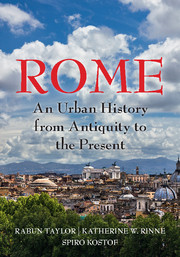Book contents
- Frontmatter
- Dedication
- Epigraph
- Contents
- List of Illustrations
- Acknowledgments
- Map
- INTRODUCTION
- 1 A BEND IN THE RIVER
- 2 A STORYBOOK BEGINNING
- 3 IDEOLOGICAL CROSSFIRE
- 4 BIG MEN ON THE CAMPUS
- 5 RES PUBLICA RESTITUTA
- 6 MEMORIALS IN MOTION: SPECTACLE IN THE CITY
- 7 THE CONCRETE STYLE
- 8 REMAKING ROME'S PUBLIC CORE: I
- 9 REMAKING ROME'S PUBLIC CORE: II
- 10 CRISIS AND CONTINUITY
- 11 RUS IN URBE: A GARDEN CITY
- 12 ADMINISTRATION, INFRASTRUCTURE, AND DISPOSAL OF THE DEAD
- 13 MAPPING, ZONING, AND SEQUESTRATION
- 14 TETRARCHIC AND CONSTANTINIAN ROME
- 15 TROPHIES AND TITULI: CHRISTIAN INFRASTRUCTURE BEFORE CONSTANTINE
- 16 WALLS MAKE CHRISTIANS: FROM FOURTH TO FIFTH CENTURY
- 17 A TALE OF TWO ROMES
- 18 THE ROME OF GOTHS AND BYZANTINES
- 19 CHRISTIAN FOUNDATIONS
- 20 FROM DOMUS LATERANI TO ROMANUM PALATIUM
- 21 THE LEONINE CITY: ST. PETER'S AND THE BORGO
- 22 VIA PAPALIS, THE CHRISTIAN DECUMANUS
- 23 THE URBAN THEATERS OF IMPERIUM AND SPQR
- 24 HOUSING DAILY LIFE
- 25 CHAOS IN THE FORTIFIED CITY
- 26 THE TIBER RIVER
- 27 HUMANIST ROME, ABSOLUTIST ROME (1420–1527)
- 28 PLANNING COUNTER REFORMATION ROME
- 29 PROCESSIONS AND POPULATIONS
- 30 MAGNIFICENT PALACES AND RHETORICAL CHURCHES
- 31 NEOCLASSICAL ROME
- 32 PICTURING ROME
- 33 REVOLUTION AND RISORGIMENTO
- 34 ITALIAN NATIONALISM AND ROMANITÀ
- 35 A CITY TURNED INSIDE OUT
- Glossary of Persons, Places, and Terms
- Works Cited
- Index
11 - RUS IN URBE: A GARDEN CITY
Published online by Cambridge University Press: 05 July 2016
- Frontmatter
- Dedication
- Epigraph
- Contents
- List of Illustrations
- Acknowledgments
- Map
- INTRODUCTION
- 1 A BEND IN THE RIVER
- 2 A STORYBOOK BEGINNING
- 3 IDEOLOGICAL CROSSFIRE
- 4 BIG MEN ON THE CAMPUS
- 5 RES PUBLICA RESTITUTA
- 6 MEMORIALS IN MOTION: SPECTACLE IN THE CITY
- 7 THE CONCRETE STYLE
- 8 REMAKING ROME'S PUBLIC CORE: I
- 9 REMAKING ROME'S PUBLIC CORE: II
- 10 CRISIS AND CONTINUITY
- 11 RUS IN URBE: A GARDEN CITY
- 12 ADMINISTRATION, INFRASTRUCTURE, AND DISPOSAL OF THE DEAD
- 13 MAPPING, ZONING, AND SEQUESTRATION
- 14 TETRARCHIC AND CONSTANTINIAN ROME
- 15 TROPHIES AND TITULI: CHRISTIAN INFRASTRUCTURE BEFORE CONSTANTINE
- 16 WALLS MAKE CHRISTIANS: FROM FOURTH TO FIFTH CENTURY
- 17 A TALE OF TWO ROMES
- 18 THE ROME OF GOTHS AND BYZANTINES
- 19 CHRISTIAN FOUNDATIONS
- 20 FROM DOMUS LATERANI TO ROMANUM PALATIUM
- 21 THE LEONINE CITY: ST. PETER'S AND THE BORGO
- 22 VIA PAPALIS, THE CHRISTIAN DECUMANUS
- 23 THE URBAN THEATERS OF IMPERIUM AND SPQR
- 24 HOUSING DAILY LIFE
- 25 CHAOS IN THE FORTIFIED CITY
- 26 THE TIBER RIVER
- 27 HUMANIST ROME, ABSOLUTIST ROME (1420–1527)
- 28 PLANNING COUNTER REFORMATION ROME
- 29 PROCESSIONS AND POPULATIONS
- 30 MAGNIFICENT PALACES AND RHETORICAL CHURCHES
- 31 NEOCLASSICAL ROME
- 32 PICTURING ROME
- 33 REVOLUTION AND RISORGIMENTO
- 34 ITALIAN NATIONALISM AND ROMANITÀ
- 35 A CITY TURNED INSIDE OUT
- Glossary of Persons, Places, and Terms
- Works Cited
- Index
Summary
THE RELENTLESS HISTORICAL EMPHASIS ON ROME'S MASONRY CORE threatens to skew our understanding of the city's life. Arguably, ancient Rome's greatest urban investment was not in its streets and buildings, but in its staggering patrimony of cultivated greenspace. Two main types predominated: the formal peristyle garden and the more sprawling, less confined horti, commonly referenced in the plural, “gardens,” to underscore their size and diversity. Both emerged roughly in parallel with the rise of luxury villas in the second and first centuries B.C.E.
The advent at Rome of the peristyle – a rectangular courtyard surrounded by an inner colonnade – dates to the Macedonian Wars of the second century B.C.E., when the Roman aristocracy was introduced firsthand to the Hellenistic aesthetic in the East. The earliest of these was the Porticus Octavia of 168 B.C.E. on the northeast side of the Circus Flaminius. The neighboring Porticus Metelli was added in 147 to enclose the existing temples of Juno Regina and Jupiter Stator. What we cannot say with any assurance is when gardens were introduced into either of these enclosures. The first was a sumptuous victory monument with bronze Corinthian capitals, but nothing is said about its plantings. The second served as a gallery for Greek sculpture, much of it war spoils; after later interventions, it appeared on the Severan marble plan – renamed the Porticus Octaviae (not to be confused with the nearly homonymous neighboring structure) because Augustus rededicated it to his sister Octavia (Fig. 74). The two parallel temples within it adjoin fountains or planting beds placed in a curvilinear, symmetrical arrangement at the rear. But this flourish belongs to Septimius Severus’ restoration after a fire in the 180s (see Chapter 10). In fact, Septimius’ inscribed monumental entrance to the enclosure still stands, embedded in the church of Sant'Angelo in Pescheria. This complex also included a schola, a place for philosophic instruction, and a curia, presumably to replace the one at Pompey's portico, which Augustus had sealed off to expiate Caesar's murder.
The Porticus Metelli was a sanctuary: this fact is essential to understanding its fashioning as a garden enclosure. The resident gods, Jupiter and Juno, were often enshrined in groves.
- Type
- Chapter
- Information
- RomeAn Urban History from Antiquity to the Present, pp. 103 - 113Publisher: Cambridge University PressPrint publication year: 2016
- 1
- Cited by



